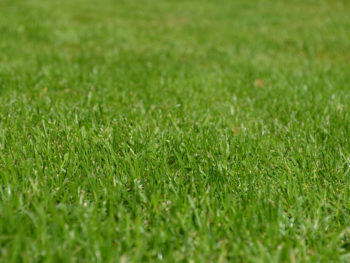Winter is just around the corner, and the temperatures are starting to drop. You won’t be mowing your lawn as much at the moment, and you’re probably not spending as much time using it either. It can be tempting to just forget about your lawn now and leave it to its own devices as we approach the colder months. While more relaxation and less lawn maintenance no doubt sounds wonderful, it’s a mistake to neglect your lawn right now. It needs a bit of care and attention to help it get ready for winter and to enable it to come through the chilly weather unscathed and in top condition. Here’s what you need to do now.
Step 1: Clean the lawn
Now is the time to remove any excess leaves, branches or debris accumulating on the lawn. If material such as this is left on the grass, it can create brown, dead spots as the grass will become mossy and mouldy underneath. This will also prevent vital winter sunlight from reaching the grass. Also check for toys, sporting equipment or timber that has been left lying around, as these will need to be removed too.
Step 2: Aerate your grass
It’s a good idea to rejuvenate your lawn now by aerating the grass. Not only will this help to ensure that winter rains (which can sometimes be few and far between) can penetrate to the grassroots, it also improves drainage in winter’s sometimes sodden conditions. Test for compaction by pushing a garden fork into the soil. If you can’t get at least half of the length of the tines into the soil, it needs treating for compaction. Using that garden fork is the easiest way to make deep holes across your entire lawn and let the air in. You could also hire a lawn aerator or coring machine to do the job.
Step 3: Apply a late-autumn dose of fertiliser
After aeration is the perfect time to give the lawn a good feed before winter. This will ensure that nutrients are effectively circulated through the soil, setting the lawn up to establish itself well once spring rolls around. It will also help to green up the lawn and keep it looking good throughout winter. Slow release fertilisers are ideal, applied at a lower application rate than your spring application of fertiliser. Spread the fertiliser evenly over the lawn and water it in well so that the nutrients can be absorbed easily.
Click here to access Horsham’s quality range of lawn fertilisers.
Step 4: Repair bare patches
If your lawn has been suffering from all the traffic it’s been getting, it’s time to repair those bare patches. The lawn is unlikely to be used as much now that it’s starting to get cold, meaning that your repairs will have a good chance to establish. You can do this in a few different ways: either sow some seed, install some new lawn turf (available here from Horsham Turf) or transplant some runners from the edge of your lawn into the bare patches.
To find out how to help your lawn repair job establish fast, click here.
It’s also worthwhile determining what is causing the bare patches, so that you can fix the problem and not keep applying a band aid solution. If bare patches are caused by excessive shade, either remove the shade-causing object (if possible) or plant a more shade-tolerant grass in that area. If brown spots are caused by pet urine, think about training your pet to use a specific area for their toilet, or watering down the area to dilute the urine after they’ve done their business. If excessive traffic is causing a lot of wear on your lawn, make sure not to use the grass as a car park and try and stay off the area while it repairs.
Step 5: Get rid of autumn weeds
If your lawn has been suffering from a long, dry spell or is compacted, it might unfortunately be full of weeds such as Bindi. Control them now so that they don’t get a strong hold in your lawn. Use selective herbicides to control the weeds, making sure to follow the directions on the packaging. This will stop the weeds in their tracks before they become painful.
Step 6: Give it a good mow before the cold really sets in
Once the really cold weather has arrived, you’ll hardly need to mow your lawn throughout most of winter. So give it one last good mow before frosts and possibly snow set in. Longer grass means more shade for the lawn, so it’s better to mow it a bit shorter to allow the grass more area to collect sunlight.
Step 7: Balance out your soil
If your lawn hasn’t been looking as good as it should and is succumbing to weeds, chances are your soil might be too acidic. Grab a pH kit and test your soil to find out. If your soil is indeed too acidic, now is a good time to add lime to your lawn to raise the pH levels.
Step 8: Clean up your lawnmower
Before you pack the lawnmower away for the season, give it a thorough “spring clean” to ensure it’s in great condition next time you need it. Make sure the blades are sharp, give it a good wipe over and check that everything is in good working order.
Looking after your lawn now will mean it’s more able to cope with the extremes of winter weather and will be ready to spring back into life when the warmer temperatures arrive.





 Warning signs your lawn needs instant turf
Warning signs your lawn needs instant turf
